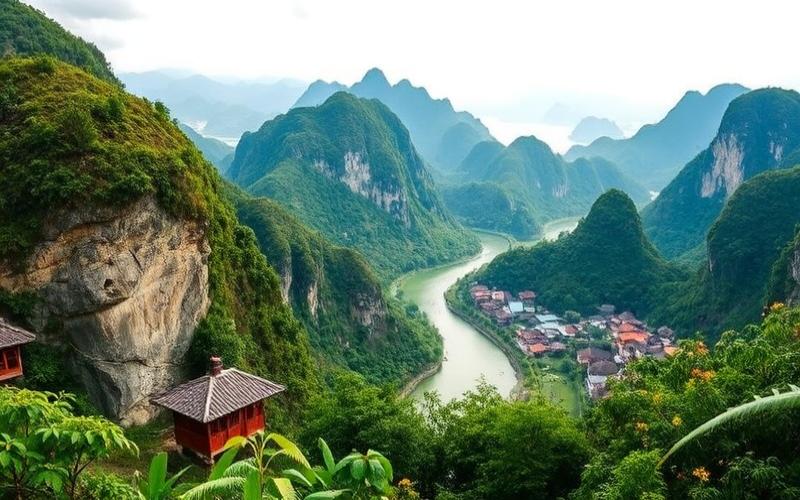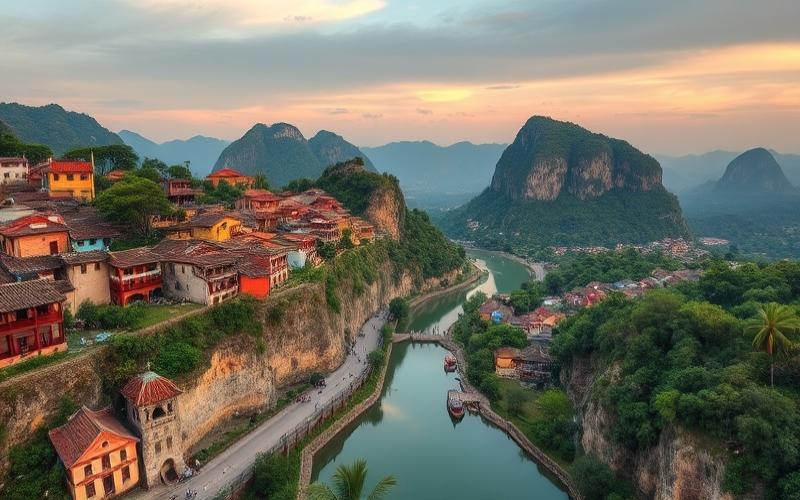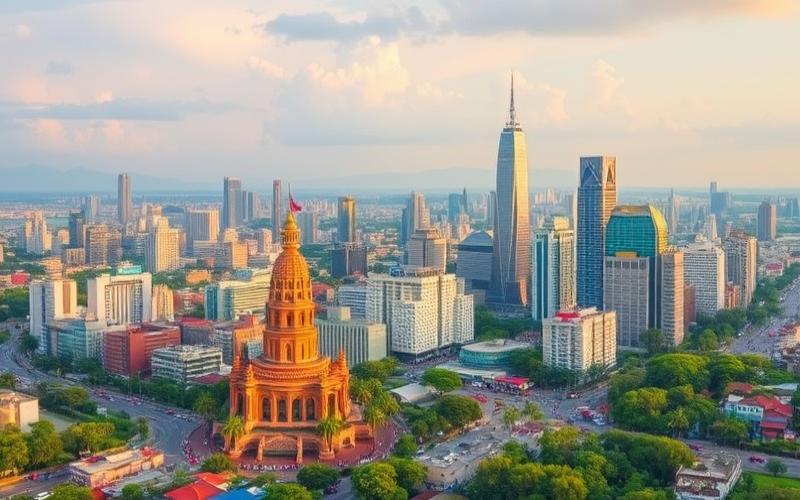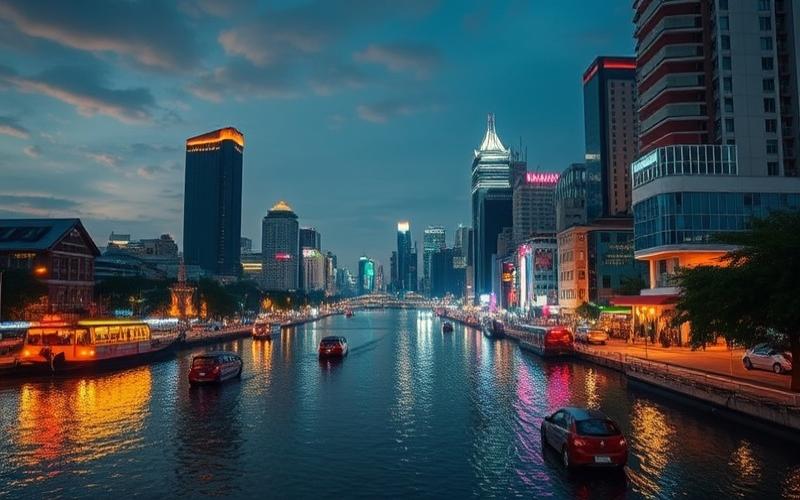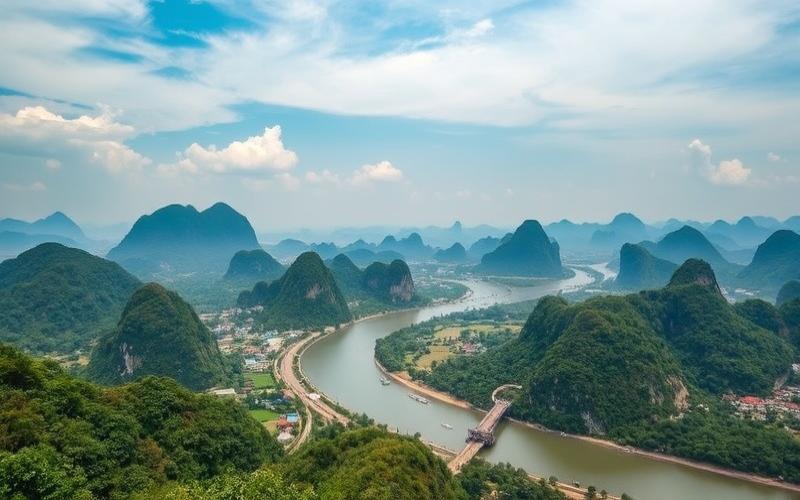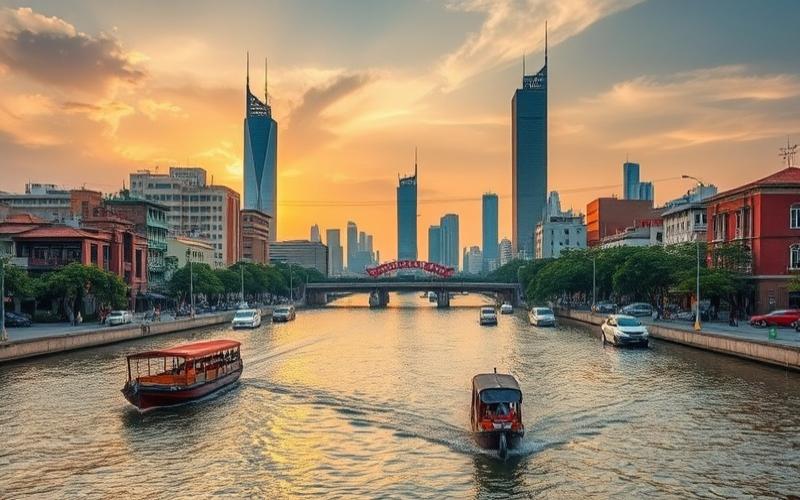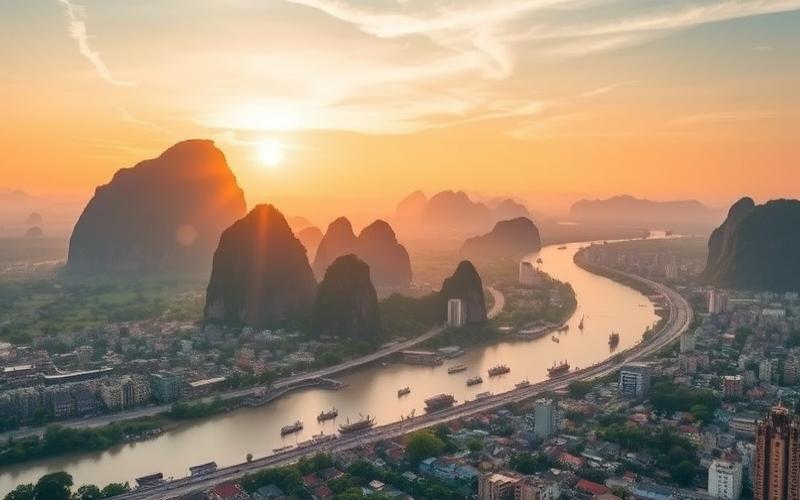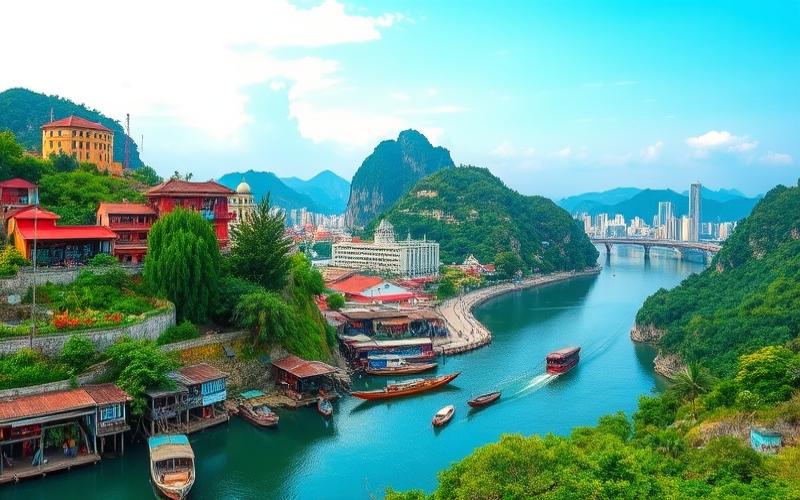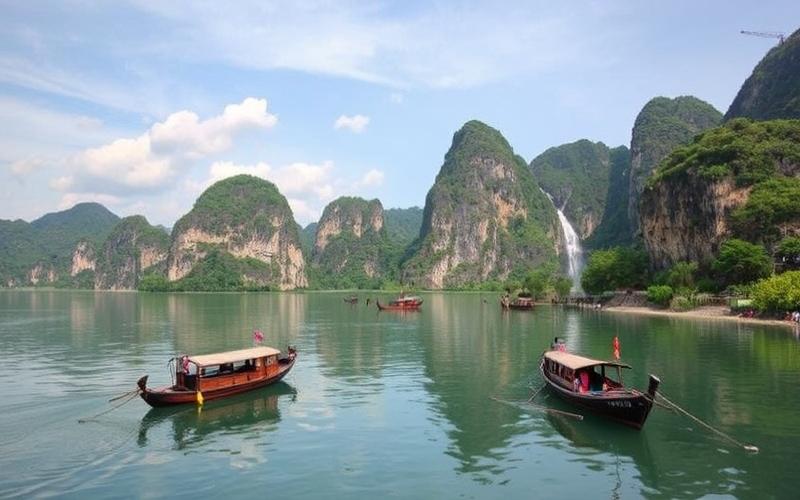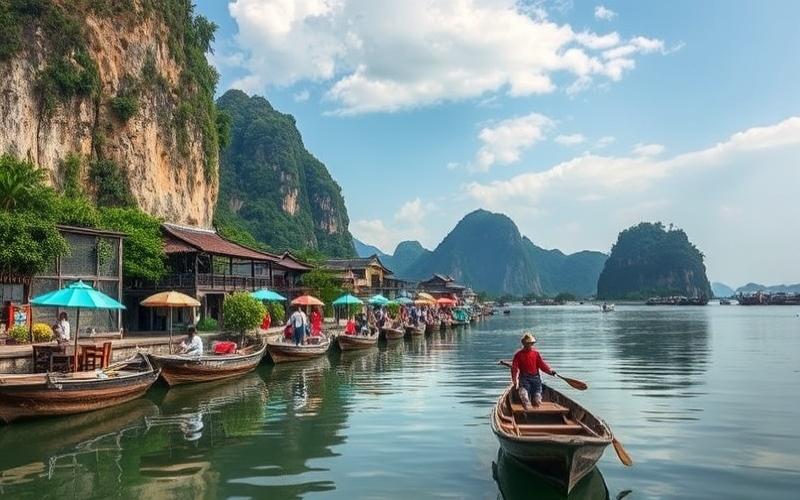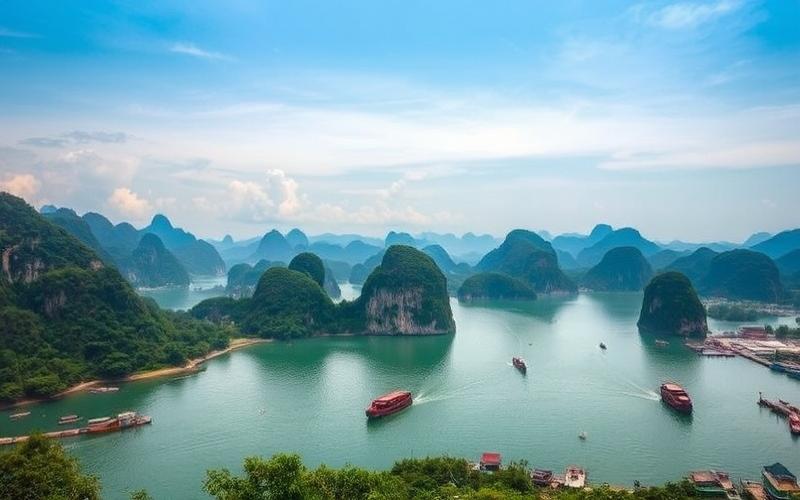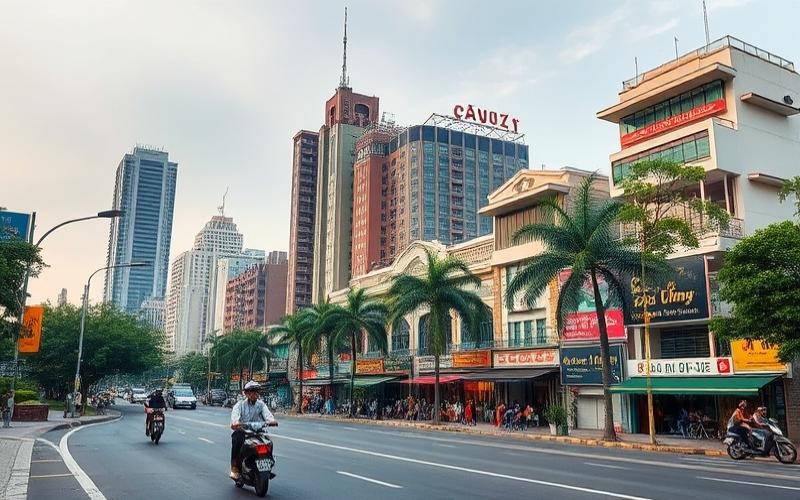
 Published on and written by Cyril Jarnias
Published on and written by Cyril Jarnias
Vietnam: A Booming Economy
Vietnam, renowned for its rich culture and picturesque landscapes, is also a booming economy, with cities transforming at an astonishing pace.
Vietnamese Real Estate by 2030
By 2030, some of these cities could see their real estate prices skyrocket, reflecting rapid economic growth and urbanization. These cities not only offer unprecedented investment opportunities but also mirror the country’s modernization, attracting talent and foreign capital.
Key Factors Driving This Growth
In this captivating article, we explore the key factors propelling this potential surge, highlighting areas that promise significant return on investment for those daring enough to venture in today.
Good to know:
Vietnam experiences an average annual economic growth of 6-7%, making it one of the most dynamic economies in Southeast Asia.
Vietnam’s Real Estate Market Trends: An In-depth Analysis
Economic and social factors play a central role in the dynamics of Vietnam’s real estate market. Among the main drivers are:
- Sustained Economic Growth: Vietnam maintains one of the fastest growth rates in Asia, with an economy considered moderately dynamic in 2025 (score of 7.45/10) and even more optimistic prospects for 2026 (8.13/10).
- Middle Class Expansion: The rise of an urban middle class stimulates residential demand and real estate investment.
- Sophisticated Investors: The arrival of increasingly professional domestic and foreign investors promotes market diversification.
- Social Stability: A stable political environment and increased investor confidence encourage transactions.
Foreign direct investment (FDI) reached $25.4 billion in 2024, up 9.4% year-on-year, supported by open policies and government incentives.
Recent Real Estate Price Statistics (2025)
| Region | Average Price per m² (USD) | Annual Change (%) | Trends |
|---|---|---|---|
| Ho Chi Minh City | 3,500 – 6,000 | +3 to +5 | Slight increase, rental market stabilization |
| Hanoi | 2,800 – 4,500 | +2 to +4 | Sustained growth, new hubs in outskirts |
| Da Nang | 1,800 – 2,800 | +5 to +7 | Strong demand in luxury segment |
| Hai Phong | 1,200 – 2,000 | +4 to +6 | Industrial and logistics appeal |
| Binh Duong/Long An | 1,000 – 1,800 | +5 to +8 | Rapid growth, proximity to industrial hubs |
Concrete example: The Thu Duc district (Ho Chi Minh City) experiences above-average growth due to the completion of major infrastructure and the arrival of multinational headquarters.
Government Policies and Foreign Investment
- Regulatory Reforms: Improved legal framework to secure transactions and facilitate property access for foreigners.
- Infrastructure Development: The state heavily invests in highways, metro in Hanoi and Ho Chi Minh City, and special economic zones, stimulating land demand in affected areas.
- Tax Incentives: Relief for developers in certain segments (social housing, eco-districts).
- Openness to FDI: Investment procedures for foreigners are simplified, especially for large residential and logistics projects.
Growth Prospects and High-Potential Cities by 2030
The following cities show the strongest growth potential and real estate price increases:
- Ho Chi Minh City: National economic center, dynamic, with infrastructure projects (metro, urban highways) expected to support 30-40% price increases by 2030 in some districts.
- Hanoi: Outskirts hubs like Gia Lam, Dong Anh and Hoai Duc are rapidly urbanizing, with expected price explosions over the next 5-7 years.
- Da Nang: Coastal city attracting investors in tourism and luxury residences, annual growth above national average.
- Hai Phong and Binh Duong: Benefit from regional industrial relocation and foreign investment in logistics, leading to strong upward pressure on land prices.
Real Estate Market Forecasts by 2030
- Expected average annual price progression between 4-8% depending on region.
- Multiplication of green and smart projects, driven by public policies and middle-class demand.
- Foreign investment expected to exceed $30 billion per year from 2027 if current pace continues.
- Outskirts of major cities (Thu Duc, Long Bien, Binh Duong) are anticipated for significant price increases, up to +50% by 2030.
Key Factors to Watch for the Next Decade:
- Evolution of interest rates and Vietnamese monetary policy.
- Stability of urban demographic growth.
- Intensified competition between local and foreign investors.
- Impact of new environmental regulations on projects.
Key takeaway:
Vietnam’s real estate market, stimulated by economic growth, rapid urbanization and openness to foreign capital, offers remarkable growth prospects in its main urban and industrial centers. Government policies and infrastructure dynamism will play a decisive role in real estate asset valuation by 2030.
Good to know:
In Vietnam, the real estate market is influenced by strong economic growth, rapid urbanization, and demographic changes, such as a rising middle class. Prices have already shown an upward trend in Ho Chi Minh City and Hanoi, where expanding urban areas attract massive investments, particularly foreign ones. In 2022, Hanoi recorded a 15% increase in real estate prices, and forecasts indicate that cities like Da Nang and Hai Phong could see similar increases by 2030, thanks to urban modernization efforts and infrastructure development. The Vietnamese government encourages foreign direct investment, thus intensifying demand. Large-scale projects, such as metro line construction in Ho Chi Minh City, are expected to further increase price pressure. Experts recommend monitoring these trends and considering purchase opportunities in the outskirts of major cities, where growth potential remains underestimated.
Vietnamese Cities to Invest in by 2030
Vietnam shows sustained economic growth, with projected GDP growth rate between 6.5% and 7.5% until 2026. This dynamic is supported by digitalization, green transition, and government policies favorable to investment, particularly in urban infrastructure, transportation, and energy. Medium-sized cities, as well as major metropolises, offer exceptional opportunities in technology, tourism, sustainable agriculture, and real estate.
Government Policies Favorable to Investment:
- Accelerated digitalization of the economy and tax incentives for technology companies.
- National plan for developing transportation infrastructure (roads, ports, airports) and green energy.
- Simplification of foreign investment procedures and strengthening of special economic zones.
Attractive Sectors:
Technology: Growth driven by influx of foreign investment, particularly in high-tech manufacturing and development of regional digital hubs.
Tourism: Rapid post-COVID recovery, diversification of offerings (ecotourism, business tourism) and upscaling of hotel infrastructure.
Sustainable Agriculture: Promotion of agritech, organic production and exports of high-value-added products.
Trends and Economic Forecasts Until 2030:
The services sector now represents 43.4% of GDP and has the fastest growth, followed by industry and construction (36.9%), then agriculture (11.2%).
Foreign direct investment (FDI) remains stable around $25 billion USD per year, with expected increases in technology sectors and urban infrastructure.
E-commerce growth exceeds 20% per year, with estimated revenue of $35 billion USD in 2025.
Comparison Table of Vietnamese Cities with High Real Estate Investment Potential by 2030:
| City | Local GDP Growth (%) | Key Sectors | Real Estate Trends | 2030 Forecasts |
|---|---|---|---|---|
| Ho Chi Minh City | 8-9 | Technology, FinTech, Services | Strong office and high-end residential demand, 8-10% annual price increase | Transformation into regional innovation hub, saturation of central districts |
| Hanoi | 7-8 | Education, Healthcare, IT Services | Expansion westward, new urban hubs, +7%/year | Sustained price growth, infrastructure development |
| Da Nang | 7-8 | Tourism, IT, Logistics | Strong tourism growth, residential and hotel demand, +10%/year | Central region’s tourism and technology hub, hotel market explosion |
| Hai Phong | 8-9 | Industry, Logistics | Industrial zones, logistics real estate, +8%/year | Rising power through exports, new residential districts |
| Can Tho | 6-7 | Sustainable Agriculture, Agribusiness | Residential development, price stability, +6%/year potential | Mekong Delta’s economic capital, green growth |
List of Growth Drivers for These Cities:
- Ho Chi Minh City: Vietnamese Silicon Valley, transport modernization, influx of tech startups.
- Hanoi: Development of university and hospital hubs, metro extension, investments in smart cities.
- Da Nang: Premier tourist hub, investments in cybersecurity and outsourcing, expanding seaport.
- Hai Phong: Industrial and port platform, arrival of major foreign groups, export dynamism.
- Can Tho: Agribusiness center, development of organic sectors, pilot projects in smart agriculture.
Good to know:
By 2030, Hanoi and Ho Chi Minh City are among the Vietnamese cities where investment could prove particularly lucrative, thanks to encouraging government policies aimed at stimulating the economy. Evolving infrastructure, supported by modern transport projects, promotes rapid urban development in these regions. Technology, tourism, and sustainable agriculture are attractive sectors, marked by rising foreign investment. Hanoi, as the capital, sees notable expansion in technology businesses, while Danang, with its growing tourist appeal, experiences strong real estate demand. Furthermore, Can Tho’s economic growth, supported by the expansion of sustainable agriculture, highlights investment possibilities. Economic forecasts indicate significant increases in real estate prices in these cities, sometimes up to 30% annually, making the market particularly competitive. Comparatively, current real estate prices there are lower than many other Asian metropolises, thus offering considerable untapped potential for savvy investors.
Key takeaway:
The real estate market in major Vietnamese cities shows growth above the national average, with annual increases of 7-10% in certain segments. Secondary cities, such as Da Nang or Hai Phong, could experience a real estate price “explosion” by 2030, driven by industrialization, tourism, and infrastructure modernization.
Macroeconomic stability, openness to FDI, and focus on digitalization and sustainability strengthen Vietnam’s attractiveness as a long-term urban investment destination.
The Impact of Economic Trends on Real Estate Prices
Recent economic trends in Vietnam, such as sustained GDP growth, rising foreign direct investment (FDI), and massive infrastructure development, exert major influence on increasing real estate prices in the country.
Major Economic Factors Influencing Real Estate Prices:
- GDP Growth: Vietnam maintains one of the fastest economic growth rates in Asia, stimulating investor confidence and real estate demand, particularly in major cities and industrial hubs.
- Rising Foreign Investment: FDI reached $25.4 billion in 2024 (+9.4% in one year), strengthening demand for offices, housing, and industrial premises.
- Infrastructure Development: Major projects (highways, metro lines, industrial zones) promote urban expansion and make new areas attractive, leading to price increases in affected districts.
| Factor | Effect on Real Estate | Concrete Examples |
|---|---|---|
| GDP Growth | Increased demand, price increases | Hanoi, Ho Chi Minh City |
| FDI | Dynamizes the sector, attracts new players | Southern industrial zones |
| Infrastructure | Land valuation, increased transactions | Long Thanh, Thu Duc |
Rapid Urbanization and Population Growth:
- Vietnam experiences accelerated urbanization, with a booming urban population and middle class.
- This dynamic creates strong housing demand, particularly in major cities and their outskirts.
- Population growth increases pressure on available real estate stock, contributing to price increases.
Government Policies:
Market Stimulation: The government implements measures to increase transparency, accelerate project approvals, and facilitate credit access.
Regulation: Restrictions remain regarding foreign ownership (limits on proportion of homes owned by foreigners in a project), but the framework is gradually easing to attract capital.
Tax Incentives: Certain zones benefit from advantageous policies to attract developers and investors (tax reductions, temporary exemptions).
Effect on Prices in Major Cities Before 2030:
Ho Chi Minh City: Infrastructure expansion (e.g., metro, highways) and economic attractiveness favor sustained price increases in central districts and new urban hubs like Thu Duc.
Hanoi: Transport modernization and FDI concentration stimulate demand for housing and offices, leading to price increases, particularly in business districts and new urban areas.
Secondary Cities (Da Nang, Hai Phong): Development of logistics and industrial infrastructure attracts investment, generating upward pressure on real estate prices.
Examples of Specific Economic Factors by City:
| City | Key Economic Factors | Impact on Prices |
|---|---|---|
| Ho Chi Minh City | Metro, FDI, technology hubs | Marked increase |
| Hanoi | Industrial zones, FDI, tertiary development | Sustained increase |
| Da Nang, Hai Phong | Ports, logistics, tourism | Rapid progression |
List of Main Drivers of Real Estate Price Increases:
- Robust economic growth
- Expanding middle class
- FDI and professional investors
- Infrastructure modernization
- Urbanization and demographic pressure
- Favorable government policies
In summary: The combination of these factors explains the upward trend in real estate prices in Vietnam, particularly in major metropolises and emerging hubs, with notable increases expected by 2030 in cities like Ho Chi Minh City, Hanoi, Da Nang and Hai Phong.
Good to know:
The Vietnamese economy is experiencing remarkable growth, fueled by increased GDP and foreign investment, particularly in cities like Hanoi and Ho Chi Minh City. This economic dynamism boosts infrastructure development, making these areas even more attractive to real estate investors. Meanwhile, rapid urbanization and population growth increase housing demand, exerting upward pressure on prices. Government policies also play a crucial role, with measures like tax incentives favoring construction and restrictions on foreign ownership to regulate the market. These combined factors indicate that real estate prices in some urban centers are likely to experience significant increases by 2030, making cities such as Da Nang or Nha Trang preferred targets for future investments.
Vietnam’s Growth Areas: What Opportunities for Investors?
The main economic and demographic growth areas in Vietnam are concentrated around major metropolises, industrial provinces in the South and North, as well as booming coastal hubs. These regions offer a wide range of opportunities for foreign and local investors.
| Region/City | Economic Strengths | Major Projects & Infrastructure | Key Sectors |
| Ho Chi Minh City | Economic metropolis, strong growth | Metro, expanded airports | Technology, real estate |
| Hanoi | Political & technological capital | Highway/railway extension | High-tech, financial services |
| Binh Duong | Key industrial zone | New industrial zones | Manufacturing, logistics |
| Dong Nai | Strong industrialization | New industrial parks | Pharmaceuticals, technology |
| Bac Ninh | Northern manufacturing hub | Expansion of industrial parks | Electronics (Samsung etc.) |
| Hai Phong | Strategic international port | Lach Huyen deep sea port | Maritime logistics |
| Danang | Tourist hub and future FTZ | Development of commercial free trade zone linked to Lien Chieu airport/seaport | High-end tourism/logistics |
Key data:
- Over 400 planned industrial zones with 300 already operational with occupancy rates above 80%.
- National GDP exceeded 7% growth in 2024; official target: +8% for 2025.
- Vietnam’s e-commerce market is expected to reach $35 billion USD in 2025.
Attractive Sectors for Investments
- Technology: Rapid growth in Hanoi/Ho Chi Minh City; development supported by national digitalization.
- Manufacturing Industry: Massive relocations from East Asia; hubs like Bac Ninh/Dong Nai/Binh Duong benefit from Japanese (SMC Manufacturing Vietnam), Korean (Hyosung), Taiwanese (Advanced Multitech) investments.
- Real Estate/New Housing: Average condominium prices surged (+36% in Hanoi over one year).
- High-end Tourism/Coastal Leisure: Danang establishes itself as a flagship destination thanks to FTZ projects and its growing international connectivity.
Strategic Infrastructure
- Massive construction or extension of national express roads/rail networks.
- New urban metro in Ho Chi Minh City/Hanoi
- Modern seaports (Lach Huyen – Hai Phong; Lien Chieu – Danang)
Government Incentives
Non-exhaustive list:
- Partial tax exemptions for several years in new free zones/disadvantaged areas
- Priority access to industrial land via long-term leases
- Accelerated administrative simplification for obtaining FDI licenses in strategic sectors
Testimonials/Successful Investors
“The macroeconomic stability combined with local incentives allows us to accelerate our productive investments. Our factory in Dong Nai industrial park is already profitable from the second year” — Asia-Pacific Director at SMC Manufacturing Vietnam
“Thanks to preferential tax measures offered in Danang’s new FTZ and its unique port/airport proximity in Central Vietnam, our regional logistics center became operational faster than expected” — CEO Mapletree Logistics Asia
Practical Recommendations for New Investors
- Prioritize provinces with heavy infrastructure already launched or guaranteed by the State
- Carefully assess land costs which vary significantly by region
- Quickly establish local partnerships to navigate sometimes complex national/provincial regulations
- Plan active regulatory monitoring on environmental developments
Potential Challenges That Could Influence Investment
- Sometimes changing regulations particularly on environmental taxation or labor rights
- Increased competition between Asian players relocating to Vietnam
- Occasional risk related to regional/global logistics tensions
- Growing environmental pressures: increasing need to integrate ESG standards from project design
⬛⬛ Opportunities remain very significant but require fine sectoral/regional analysis as well as active management of regulatory/environmental risks.
Good to know:
Vietnam is experiencing notable economic growth, with cities like Ho Chi Minh City, Hanoi, and Da Nang standing out for their demographic and economic dynamism. Technology, tourism, manufacturing, and real estate sectors represent interesting opportunities for investors, supported by promising growth forecasts. The government encourages investment through tax incentives and simplification of administrative procedures. Key infrastructure, such as urban transport networks and airport improvements, are under development, supporting this growth. Success stories, like those of technology companies that have capitalized on the local market, illustrate the potential of these areas. However, investors must consider challenges, including regulatory and environmental ones, as well as increasing competition. A thorough understanding of the Vietnamese legal framework and local trends is essential to maximize return on investment.
Disclaimer: The information provided on this website is for informational purposes only and does not constitute financial, legal, or professional advice. We encourage you to consult qualified experts before making any investment, real estate, or expatriation decisions. Although we strive to maintain up-to-date and accurate information, we do not guarantee the completeness, accuracy, or timeliness of the proposed content. As investment and expatriation involve risks, we disclaim any liability for potential losses or damages arising from the use of this site. Your use of this site confirms your acceptance of these terms and your understanding of the associated risks.




